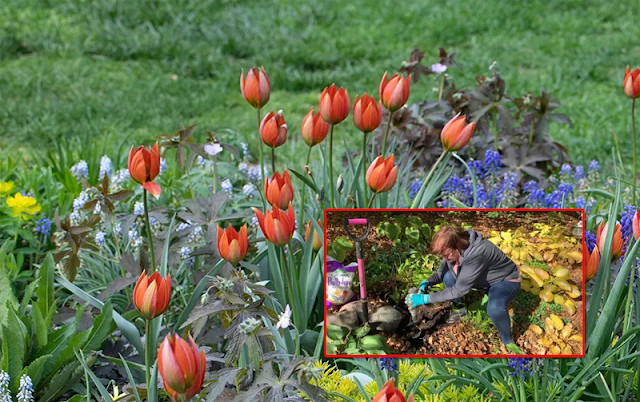Gardening in Autumn: Plant Selection and Maintenance
In the fall, it's easier to decide where to plant new additions to your garden because you have a complete view of your garden. In spring, there's a risk of accidentally digging up forgotten plants that haven't sprouted yet. To help you with your autumn gardening, here's some valuable information on planting and the bulbs and perennials to consider.
How to Plan Your Garden in Autumn
Soil Preparation
Invest a few hours in preparation and planning, and you'll reap the benefits. Generally, bulbs thrive in well-drained soil. Soil that's too dry or too wet isn't conducive to their survival. It's advisable to loosen the soil first. If heavy rain is expected, postpone planting, as muddy conditions can suffocate your bulbs. To encourage blooming, add organic compost to the soil.
The Right Time for Planting Bulbs
Typically, bulbs that will bloom in spring should be planted in the autumn. Depending on your region, you can plant seeds in September, October, or early November, depending on the soil temperature, which should be around 55°F (13°C). Planting bulbs too early may prevent them from thriving, while planting them too late may expose them to freezing conditions without sufficient root development.
Choosing the Right Location
Bulbs can find a home anywhere in your garden, from flower beds to rock gardens or as borders. Aesthetically, consider color combinations, height balance, and foliage appearance. When it comes to sunlight exposure, follow the instructions on the packaging. Some plants prefer full sun, while others thrive in partially shaded areas.
Planting Bulbs
To protect your bulbs from the fluctuating temperatures, including frost and thaw cycles, plant them at a depth approximately three times their height. Some people opt for a mulch cover to provide additional protection. The distance between bulbs should be based on the flower diameter and size.
Recommended Autumn Bulbs
Autumn-planted bulbs can be combined with perennials, provided they enjoy sunlight. These bulbs will brighten your lawn with various colors come spring. Over time, your arrangement will expand, creating a more spectacular visual impact.
From the wide variety of bulbs available, you can choose crocuses and snowdrops, which will display vibrant colors early in the spring. Tulips, with their incredible array of varieties and hues, can be planted almost anywhere in your garden – in flower beds, at the base of trees, along hedges, or even in pots on your terrace. Daffodils, hyacinths, lilies, and jonquils are all precious additions to your garden.
The options are vast, and you have the freedom to be creative. Don't shy away from abundance for a more striking effect. A mass of flowers can create a more captivating sight than orderly rows.
Protecting Bulbs from Rodents
If squirrels tend to unearth your bulbs, here are some preventive measures:
- Grow less attractive varieties for small rodents, such as ornamental garlic, hyacinths, and grape hyacinths.
- Place a metal grid over your seeds before covering them with soil.
- Squirrels dislike the smell of certain fertilizers (e.g., chicken manure); follow the recommended dosage.
- Human hair and cat fur act as repellents for rodents. Spread them around your seeds.
- Motion detectors can also be effective.
It's also the time to store summer bulbs. Some bulbs, such as begonias, calla lilies, dahlias, gladioli, and lilies, need to be dug up and stored in a cool, dry place, such as a root cellar, ideally at around 41°F (5°C). However, specific conditions may apply, so consult your local nursery.
Autumn-Planted Perennials
Perennials can typically be planted year-round, except during freezing temperatures. However, autumn is the ideal time to divide perennials that bloom in spring (e.g., phlox, forget-me-nots, bleeding hearts, foamflowers, and tiarellas) in regions with cold and damp climates to protect them from winter cold and heavy rainfall. In milder climates, planting in autumn or spring is recommended since perennials don't tolerate drought and high temperatures.
Garden centers offer discounted perennials waiting for you. Traditionally, perennials were planted in spring, but autumn (from mid-September to early November, depending on your region) remains the perfect season. Why? The soil is warm, rainfall is ample, and evaporation due to the sun's warm rays is less significant. Remove the plant from the pot and plant it in the desired location. It will thrive without issues.
For autumn-blooming perennials (e.g., autumn chrysanthemums and Japanese anemones or asters), take precautions: once planted, remove the flowers and cut the plant in half. This promotes healthier root growth. Rest assured, perennials adapted to your hardiness zone will withstand autumn frosts and winter's freezing temperatures. You won't have to wait a year for a more abundant bloom.
Preparing Plants for Winter
To cut or not to cut? Opinions on preparing the garden for winter are divided. A call to a garden center sheds light on this matter. While landscapers often cut perennials and flowers in the fall, it's not mandatory for amateur gardeners. Keeping plants intact during winter doesn't harm them. In fact, their leaves provide protection from wind, cold, and snow accumulation. There's one exception: plants that suffered from disease during summer. To prevent reoccurrence in spring, cut the flowers and leaves to about 4 inches (10 centimeters) from the ground, just as you would in late April.
In summary, you don't need to stress over garden maintenance today. Everything can wait until the return of better weather.

